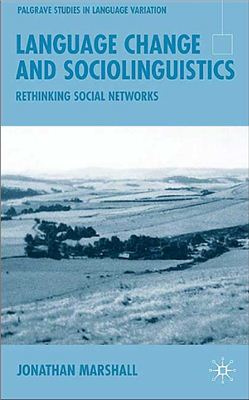N. Y. : Palgrave Macmillan, 2004.— xiv, 246 p.
This book presents a sociolinguistic study based on mode recorded dialect data. The purpose of the study was to develop a theoretical sociolinguistic framework which can aid our understanding of the diffusion of language change within a community. The study was conducted in order to establish what social factors might be involved in the process of language change, though the particular emphasis was on resistance to change. Some speakers of the variety studied, known in Scotland as ‘the Doric’, seem to have resisted change quite strongly, and this has drawn attention to the area. Sociolinguistic theory attempts, among other things, to explain the factors and motivations involved in the process of language change, and the social network framework has in the past been influential in our understanding of the process of veacular maintenance. This study replicates the methodology used in most network studies, but also incorporates other sociological, including various attitudinal, factors. This was done by building up sociological and linguistic indices for each individual, and testing for correlations between the various indices. The results will indicate a cautious view of the ability of the supposed norm-enforcement effect of social networks to adequately account for veacular maintenance. A more complex, inclusive model is offered, incorporating attitudinal factors, such as orientation to the local community. Social factors have been considered to operate simultaneously but variably on the individual. As such, the methodology developed here has the ability to consider the effects of the various sociological variables simultaneously.
Palgrave Macmillan Studies in Language Variation Series
ISBN 1-4039-1487-7
Contents
Historical and Demographic Details
Theoretical Background and Previous Research
The Research Design
Correlations Between Age and the Individual Phonological Variables
Testing for Correlations Across the Entire Database
Statistical Testing
Discussion
Implications for Future Research
This book presents a sociolinguistic study based on mode recorded dialect data. The purpose of the study was to develop a theoretical sociolinguistic framework which can aid our understanding of the diffusion of language change within a community. The study was conducted in order to establish what social factors might be involved in the process of language change, though the particular emphasis was on resistance to change. Some speakers of the variety studied, known in Scotland as ‘the Doric’, seem to have resisted change quite strongly, and this has drawn attention to the area. Sociolinguistic theory attempts, among other things, to explain the factors and motivations involved in the process of language change, and the social network framework has in the past been influential in our understanding of the process of veacular maintenance. This study replicates the methodology used in most network studies, but also incorporates other sociological, including various attitudinal, factors. This was done by building up sociological and linguistic indices for each individual, and testing for correlations between the various indices. The results will indicate a cautious view of the ability of the supposed norm-enforcement effect of social networks to adequately account for veacular maintenance. A more complex, inclusive model is offered, incorporating attitudinal factors, such as orientation to the local community. Social factors have been considered to operate simultaneously but variably on the individual. As such, the methodology developed here has the ability to consider the effects of the various sociological variables simultaneously.
Palgrave Macmillan Studies in Language Variation Series
ISBN 1-4039-1487-7
Contents
Historical and Demographic Details
Theoretical Background and Previous Research
The Research Design
Correlations Between Age and the Individual Phonological Variables
Testing for Correlations Across the Entire Database
Statistical Testing
Discussion
Implications for Future Research

